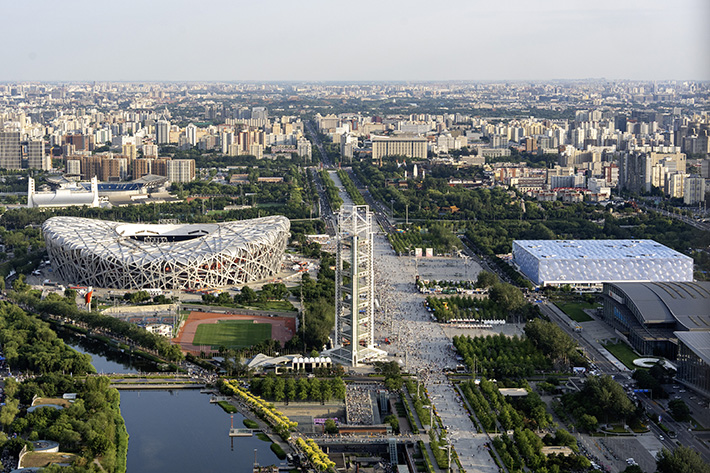|
||||||||||
| Home Top News Economy/Tech Culture/Sports China in Foreign Eyes Green Development Videos Intangible Cultural Heritages |
|
||||||||||
| Home Top News Economy/Tech Culture/Sports China in Foreign Eyes Green Development Videos Intangible Cultural Heritages |
| ChinAfrica |
| Bridging Continents Through Heritage |
| From the Yangtze to the Nile, a shared vision for world heritage protection is charting a new course in global cultural cooperation |
| By LI XIAOYU | VOL. 17 July 2025 ·2025-07-14 |

A view of Beijing’s Central Axis from the Olympic Tower, Beijing, on 15 June (CNS)
Thousands of kilometres apart, two ancient hydrological relics – the White Crane Ridge (Baiheliang) in the middle of the Yangtze River in Chongqing and the Nilometers on Rhoda Island in Cairo – stand as silent witnesses to humanity’s interaction with nature across centuries. Today, they form the centrepiece of a historic cultural partnership: a joint China-Egypt bid for UNESCO World Heritage status.
This symbolic effort is part of broader China-Africa collaboration in cultural heritage preservation. As a sign of deepening cooperation, the China-Africa-UNESCO High-Level Dialogue on Cooperation in Education and Cultural Heritage Protection was held on the sidelines of the 2024 Summit of the Forum on China-Africa Cooperation in Beijing. Themed “Jointly Promoting Educational Development and Cultural Heritage Protection in Africa,” the dialogue identified cultural heritage protection as a prerequisite for the progress of human civilisation and the world’s sustainable development.
It underscored the importance of strengthening cooperation in education and cultural heritage preservation in implementing three global initiatives: the UN 2030 Agenda for Sustainable Development, the African Union Agenda 2063, and the development of a global community with a shared future.
China’s legacy of protection
China’s success in heritage conservation serves as a model for developing nations. Since joining the UNESCO Convention on World Heritage in 1985, China has achieved World Heritage status for 59 sites – 40 cultural, 15 natural, and 4 mixed – making it one of the most active countries in the field.
“The heritage nomination and management process has not only improved our conservation work but also brought lasting economic and social benefits to the regions involved,” said Song Xinchao, president of the Chinese Society of Cultural Relics.
A striking example is Beijing Central Axis: A Building Ensemble Exhibiting the Ideal Order of the Chinese Capital, inscribed on the UNESCO World Heritage List in July 2024. Spanning 7.8 km and featuring 15 key sites from imperial palaces to ancient city infrastructure, the axis exemplifies traditional Chinese urban philosophy and the cultural ideals of “centre” and “harmony.”
According to Edmond Moukala, head of the UNESCO Office in Bamako, Mali, China’s journey from its first six heritage sites in 1987 to nearly 60 today demonstrates the country’s dedication. “This progress reflects years of consistent effort by the Chinese government and scholars alike,” he said.
Africa’s challenges
Despite its rich cultural and natural resources, Africa faces daunting challenges in heritage protection. According to statistics from the UNESCO World Heritage Centre, the Africa region currently has 98 properties inscribed on the World Heritage List – 54 cultural, 39 natural, and 5 mixed – representing just 9 percent of the list. Fifteen properties are on the List of World Heritage in Danger – the highest of any region.
Africa’s endangered properties suffer from weak management and external threats such as mining, armed conflict, illegal poaching, and inadequate funding. For instance, in the Democratic Republic of the Congo, oil exploration threatens the habitat of mountain gorillas in Virunga National Park. In Tanzania, the Selous Game Reserve was declared endangered in 2014 due to rampant poaching and dwindling wildlife.
“The low percentage of heritage listings is incongruent with Africa’s cultural wealth,” noted Song. “The high-risk status reflects a critical need for better support systems.”
Finding solutions
In response, China and African nations are pursuing multi-level cooperation. In Ghana, Huawei and local partners are using VR and AR to create immersive experiences of historical sites. Visitors and youth can virtually explore reconstructed forts, fostering engagement and awareness.
China has signed cultural cooperation agreements with 52 African countries, many of which include heritage protection clauses.
It has also inked pacts with Ethiopia, Egypt, and Nigeria to curb the illegal trafficking of artefacts and has participated in joint archaeological missions in Egypt’s Karnak Temple complex and Kenya’s Lamu Archipelago.
Furthermore, both sides are sharing expertise in museum management, artefact conservation, and the repatriation of cultural property lost to colonialism. These initiatives are building both capacity and solidarity.
Looking ahead, the future of China-Africa cooperation in heritage protection appears bright. Both parties have pledged deeper engagement in international rulemaking to ensure that developing countries’ voices are heard. Joint efforts will continue in cross-border collaborations like the Baiheliang-Nilometers bid.
Song said, “China is committed to sharing its knowledge and experience with Africa. Through mutual learning, we can jointly safeguard the cultural treasures of our civilisations.”
| About Us | Contact Us | Advertise with Us | Subscribe |
| Copyright Beijing Review All rights reserved 京ICP备08005356号-5 京公网安备110102005860号 |